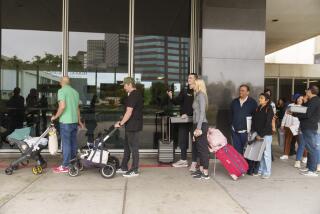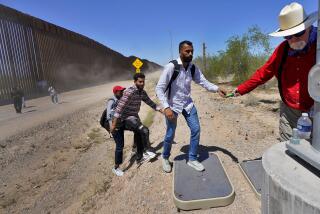New passport card may be ready by April
A new card that Americans can use to cross the Mexican and Canadian borders may be issued as early as April at less than half the cost of a passport, the U.S. State Department said Monday.
Like the passport, it will contain a computer chip that can be read remotely by scanners, which critics say raises privacy and security issues. The State Department says the chip does not pose problems in these areas.
The passport card is the U.S. government’s latest attempt to tighten border security.
Currently, Americans returning to the U.S. by air must present a passport at U.S. border checkpoints, but those returning by land or sea from Mexico, Canada, the Caribbean and Bermuda do not need one.
By summer 2009, under a deadline that Congress recently extended by a year, most land and sea travelers will need to present a passport, the new passport card or other high-security documents (still under development) to cross these borders.
Details are still being worked out, and there are exceptions to the proposed rules. But here are some questions and answers, based on a final rule published Monday in the Federal Register and on interviews with government officials:
Question: When will the passport card be available?
Answer: “Frankly, we’re aiming for . . . sometime in April and May,” Ann Barrett, deputy assistant secretary for passport services at the State Department, said in an interview Monday. She said the department hopes to award the contract to make the cards in the next few weeks and to allow Americans to apply for them a month or two in advance.
Q: Will you be able to use it everywhere?
A: No. Unlike a passport, the passport card will be accepted only for land and sea crossings into the U.S. from Mexico, Canada, the Caribbean and Bermuda. Air passengers will not be able to use it; they need a passport.
“Basically, the passport card is a limited-use passport,” Barrett said, adding that it’s intended mainly for “the border population that does frequent cross-border travel.”
Q: What will the card cost?
A: The card will cost $45 for adults and $35 for children younger than 16; renewals will costs $20 for adults and $10 for children. New passports, by comparison, cost $97 for adults and $82 for children; renewals cost $67 for adults and $52 for children.
Q: How long will the card be valid?
A: Like a passport, the card will be valid for 10 years for adults and five years for minors. Then you must apply to renew it.
Q: What it will look like?
A: Much like a driver’s license. It will have a photo of you and printed information similar to what is on a passport: name, date and place of birth, gender and the card’s issuance and expiration dates. A computer chip will be embedded in it.
Q: What will be on the computer chip, and how will it work?
A: The chip will contain only one piece of data: what the State Department calls “a unique identifying number that has meaning only inside the secure CBP [U.S. Customs and Border Protection] computer system.” Border officials will use radio frequency identification, or RFID, scanners to “read” the chip at checkpoints, just as they do with chips on new passports.
Unlike the chip on a passport booklet, which officials say has a range of 4 inches, the chip on a passport card will be readable from about 20 feet, said the State Department’s Barrett. (Some critics contend that, with powerful enough equipment, the passport-booklet chip also can also be read from many feet away.)
Q: Can someone use the RFID chip to steal your identity?
A: The answer depends on whom you talk to.
“We’ve addressed the privacy concerns,” Barrett said. She said a protective sleeve would be issued with the passport card to block electronic skimming by unauthorized users and that, in any event, the chip contains only one number.
“There will be no biographical data on it,” she said.
That’s less information than appears on a passport’s chip, which contains a digital version of your photo plus information from your main passport page. (The cover of the passport book contains a metallic material designed to prevent the chip from being read when the book is closed.) Neither chip contains your Social Security number.
Some experts are skeptical about the security for the passport card’s data.
“I’m not impressed,” said Bruce Schneier, chief technology officer of the BT Counterpane security company in Santa Clara, Calif.
Although the protective sleeve “seems like a plus,” Schneier said, the chip is potentially readable from farther away than the one on a passport. He also said it was “idiotic” to think that limiting data on the card chip to one number would prevent identity theft. He said any number could be linked to other personal data within a computer system, including Social Security numbers.
Another expert, Daniel Bailey, co-author of a 2006 study of RFID technology, said the passport card’s chip lacked security features on the passport version that could prevent cloning.
“It puts all the trust in the vigilance of the border control agent” to detect fraud, said Bailey, senior research scientist at RSA Laboratories in Bedford, Mass.
Schneier and others said that because RFID technology is complex and allows remote access to data, it is vulnerable to hacking and other security breaches.
Q: Is the State Department ready to meet the demand for passport cards and passports in 2008? Or will we face record delays in processing, as we did in 2007?
A: It’s impossible to say for sure.
“We certainly have ramped up,” said the State Department’s Barrett. “We have hired hundreds of passport specialists. We fully expect to meet the demand in 2008.”
The hires include 400 people during Fiscal Year 2007, which ended Sept. 30, plus “we’re hoping to have another 400 on board by the end of February or March,” Barrett said.
But she, added, “We’re not sure how many people will apply for the passport card,” so the State Department is doing surveys to “refine our projections.”
In Fiscal Year 2007, the department issued more than 18 million U.S. passports, up from about 12 million the prior year. In 2008, it expects to issue about 23 million to 26 million passports, Barrett said.
Q: Will there be new alternatives to the passport card?
A: Possibly. Several states, including Washington, Vermont, Arizona and New York, are testing a driver’s license with enhanced security features, said Laura Keehner, spokeswoman for the U.S. Department of Homeland Security.
Q: What is the next deadline for tightened border security?
A: Jan. 31 .Starting then, the U.S. government will begin phasing out what it calls “the routine practice of accepting oral declarations alone at land and sea ports of entry.” U.S. and Canadian citizens will need to present at least a birth certificate or other proof of citizenship, plus a government-issued photo ID such as a driver’s license, to cross borders
The new passport card, whenever it gets issued, would also likely be accepted for U.S. citizens making these types of border crossings, Keehner said.
Q: When is the best time to apply for a passport?
A: Right now. Fewer people apply for passports in winter. But toward the end of January, the pace picks up, Barrett said. “March is traditionally our busiest month,” she added, with the heavy load continuing through June. Right now, Barrett said, it’s taking about four to six weeks to process a passport application.
Q: Where can I get the latest information about passports, passport cards and how to apply for them?
A: Go to www.travel.state.gov.
jane.engle@latimes.com
More to Read
Sign up for The Wild
We’ll help you find the best places to hike, bike and run, as well as the perfect silent spots for meditation and yoga.
You may occasionally receive promotional content from the Los Angeles Times.






